Litterbox Training
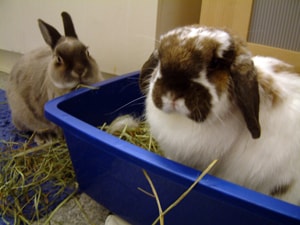
Litterbox Training
Tips and Tricks for Litter Training your Bunny.
Many people are surprised to find out that rabbits can be litter trained. Some bunnies get it in a few days, others in a few weeks, or even longer. Don’t get discouraged, I found that persistence pays off.
Bunnies are creatures of habit. Even a few weeks may be too short for the some bunnies. Though my other two rabbits got it within a week, Bailey took months, and even then I had to watch to make sure she didn’t fall back into old habits. It only takes a few days to establish bad habits, and it can mean weeks of retraining.
Baby bunnies and bunnies that aren’t spayed and neutered may be tougher to train. It still a good idea to litter train babies, some will get it, some will be more difficult, but either way, it’s a good idea to help develop good litter box habits – even if they become challenging during sexual maturity. The early training will help cement litter box habits so that they will know what to do when their hormones have died down (and after neutering)
Note: If your bunny was litter box trained and then all of a sudden began losing his/her good habits and nothing else changed, (no new animals, environment changes, etc.), then you may want to make sure there is nothing medically wrong, like a Urinary Tract Infection. It would be a good idea to have your rabbit-savvy vet check out your bunny to rule a medical issue. For other medical issues that may hinder litter box training scroll down to Trouble-shooting tips (at the bottom).
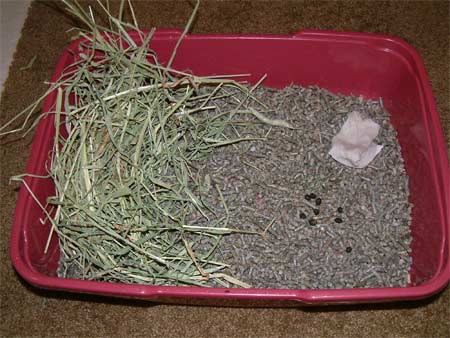
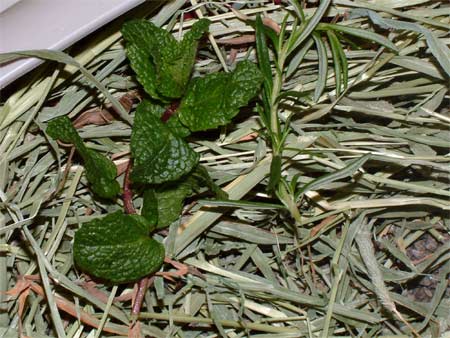
Add a healthy treat: I like to add a small amount of a pleasant smelling herb like mint, basil, or rosemary in their litter box. It not only smells good, but it’s a tasty treat for them too, and great encouragement to get in.
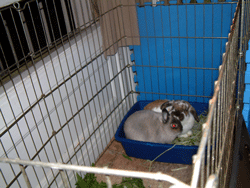
Actual Training
Start small: If a bunny is given too much freedom too fast, that just invites a poopfest. So, I allow my bunny to master one area before moving him/her to the next. If your only space right now is a small cage then I suggest getting an x-pen to allow at least some space to stretch and exercise while he’s confined. This won’t be forever, just until he is litter trained. Usually takes a few weeks.
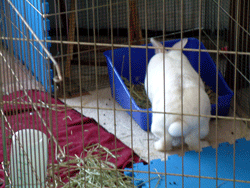
Find the favorite corner: They usually do their business in a favorite corner. I put the “prepared” litter box in that corner. If my bunny decides on a few corners, then I put in a few litter boxes. I have found that they begin to prefer one, and I slowly take out one at a time.
Become a Clean Freak and clean up urine mishaps asap:
It also helps to clean up any urine that’s outside the box as soon as you notice it, (including blankets/linens). It can really be tiring at first, but diligence can pay off.
If you notice this increases marking instead, then your bunny may actually need to feel more secure by leaving his scent around a bit, so you may want to back off on the Clean Freak method and see if your bunny marks less
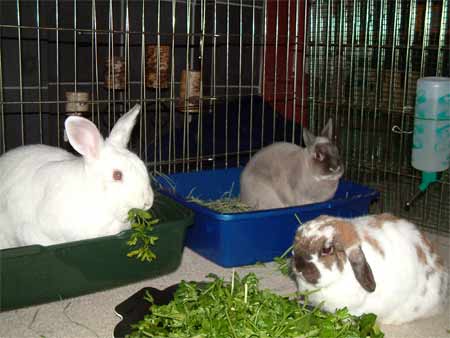
Training Sessions – Catch ‘em in the Act: I find this to be the most effective training tool. The best way to catch ‘em in the act is to spend time with your bunnies everyday around the time they eat. This is when they will most likely need to poo too!
Each time you catch your bunny lifting its tail to pee or poo, at that very moment, say “Eh uh!” or “No!” and herd him or nudge him to the litter box. (it doesn’t help to do it after he’s done the deed). You may even want to put the first part of his body in the box. Best to allow him to get in the box so he will understand going into the box himself.
It is also helpful to teach your bunny to understand the word litter box so he will go there when you say the word. See tips on how to do this below.
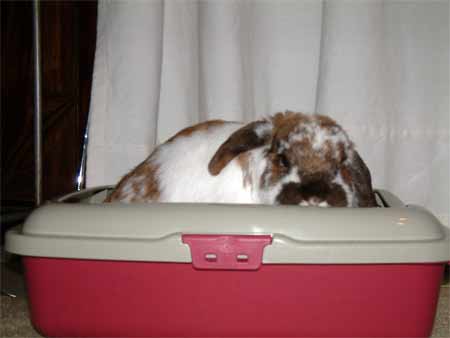
Giving More Freedom
This is when great habits can go down the drain. It’s important to allow limited freedom and watch like a hawk.
Should the litter box be only in their cage/pen? Many bunnies will still go back to their cage or area to pee and poop, but if you have a large house, or there is a corner in a room that just seems to be a continuous target no matter how much you’ve trained him/her, then I would put a litter box there.
Make sure to still catch them in the act in any new space. You’ll need to be diligent about watching until they are completely trained in every place. In larger spaces, like the living room, I bring a water bottle, and give a quick squirt. It reaches them fast and right when they are lifting their tail. Then I herd them back to their litter box. Again, don’t chase! If they just refused to get it, I would only then pick ’em up and place them just in front of the litter box, blocking escapes, so they can jump in the box on their own. Then I quickly back away so they feel safe to stay in there.
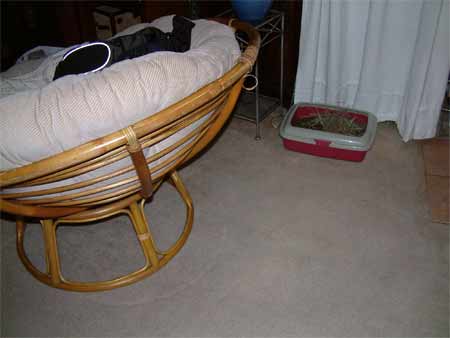
Teach the word “Litter box”
Say the word “litter box” over and over while herding your bunny to his box. Make sure not to chase or terrify him. That will only seem like punishment and they will avoid the box. Just gently and persistently herd and guide. As soon as they jump back into the box, you back off. Your bunny will learn that getting in the litter box makes you back off
Tip for bunnies who refuse to get in to the box: If after a few minutes of herding, pick ’em up and place them just in front of the litter box, blocking escapes, so they can jump in the box on their own. Then quickly back away so they feel safe to stay in there.
You can also give a treat, unless your reaching down toward him makes your bunny jump out of the box. Just see how your bunny reacts. After a while, you should be able to just say the word “litter box” a few times before your bunny goes there.
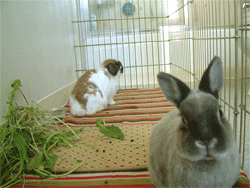
Tips for Stubborn Bunnies
STAY OUT OF THEIR SPACE:
Some territorial bunnies just figure everywhere is fair game for territorial marking. And it doesn’t help if you are reaching into or entering their space. This may confirm that they don’t really have a space of their own, therefore, it’s all their space.
SO………
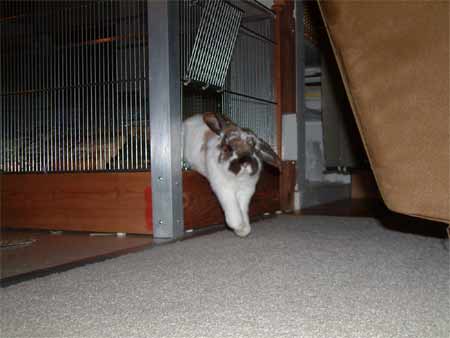
…..I let their space, their cage, be a place that is THEIRS. I don’t clean or reach in while they are in there. (I may drop food and water in, but that’s it). I try not to reach in to get them or physically lift them up and put them back in.
Instead, I let them come out on their own
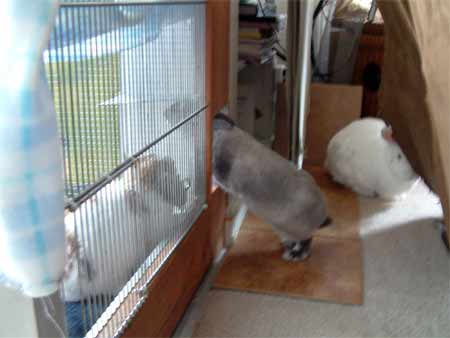
And if I can’t herd them back in after play time, then when I do pick them up, I place them just outside the entrance, blocking an escape so they go back in on their own.
Once they become litter trained, then I can usually reach in and pet them and offer affection in their territory. But if you find that that makes things worse, then of course don’t do that anymore. 🙂
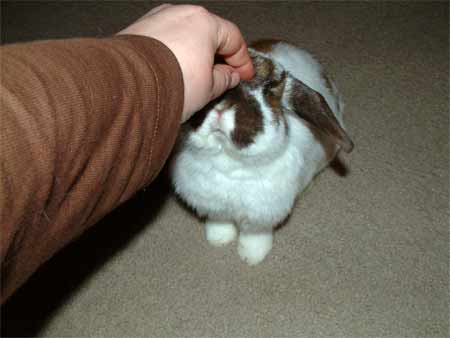
Bailey – The Persistent Marker
My solution w/ Bailey:Spend time with her on the floor.
Even though Bailey mastered the litter box in her area, she has what I jokingly call OMD – Obsessive Marking Disorder, As soon as she gets freedom, she begins marking one small area in the living room with territorial pills. (and having a litter box there didn’t help)
So I started observing her. Unlike my other bunnies who want to run and explore, Bailey immediately looks for attention.
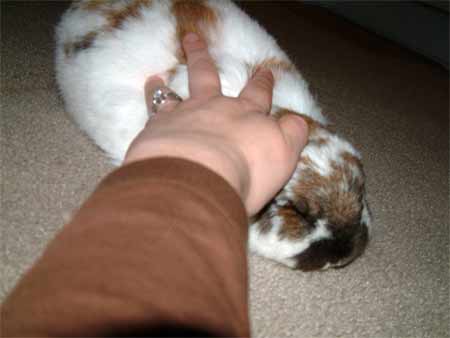
…So as soon as I let her out, I lay on the floor in the area that she likes to mark and I pet her. For some reason that has helped decrease her marking. Maybe this makes her feel secure so less need to mark. Maybe since I’m on the floor too, she’s sees it not as just her area, or maybe she feels she doesn’t have to prove her dominance through marking since she’s getting “dominant rabbit treatment” aka: grooming/petting. I’m really not sure, but whatever the reason, her marking diminishes in that area if I follow that routine.
UPDATE: Bailey rarely marked in the general area, but she took to making her own pen look like a poo bomb went off. But as long as she keeps her poos in her pen, I’m happy.
- Litter box too clean? Could the box still have a strong detergent smell? Make sure to rinse well and put in some of their own poo back in.
- Litter box too dirty? Some bunnies will begin going outside of the box if their box is filthy.
- Scented Litter? Some litters have a strong wood or perfumed additive that is offensive to some bunnies. (e.g. I accidentally grabbed the “fresh scented” Yesterday’s News litter, instead of the unscented. Boy, what a mess – my bunnies wanted nothing to do with the litter box)
- Litter box seem like punishment? When litter training, you don’t want to scare your bunny into the litter box. That will only have the opposite effect. Never chase him or yell at him to get in the litter box. If you are working on the “herding” method, then offer a treat once your bunny gets in the box.
- Give ‘em enough space once they’re in. Though some places suggest to offer a treat when the bunny goes in. I have found more success when I just quickly back away once they jump into the box. I can say “Good Job” and have a treat for him in there already, but I find it better to keep out of his business while he’s doing his business.
- The Cloth Trick to help minimize TERRITORIAL marking: A member posted about this in the forum, and I have also seen this on the show “Barking Mad”. Rub a cloth all over your bunny, then rub the cloth on the area he likes to mark. The idea is that s/he will no longer feel the need to spread his scent around if it’s already there. The few people that have tried this have said it works. Note: Territorial marking is very difficult to eliminate completely if your bunny is not spayed/neutered.
- Still Baffled? Just start observing when your bunny does it and where? Is it right away? Is it in one particular area or all over the place? Post in our FORUM, and we’ll help you get to the bottom of it.
- MEDICAL ISSUES: if all else fails, have a rabbit-savvy vet examine a persistent urinator for an underlying medical condition. Weight issues, Arthritis, Urinary Tract Infection, High Hormone levels are just some of the things that can prevent your bunny from being successfully litter-trained. (Thank you Diane J. for emailing me this very important tip!)
Do you have some great litter training tips? Contact Us, and put “Litter Training Tips” in the subject line.

